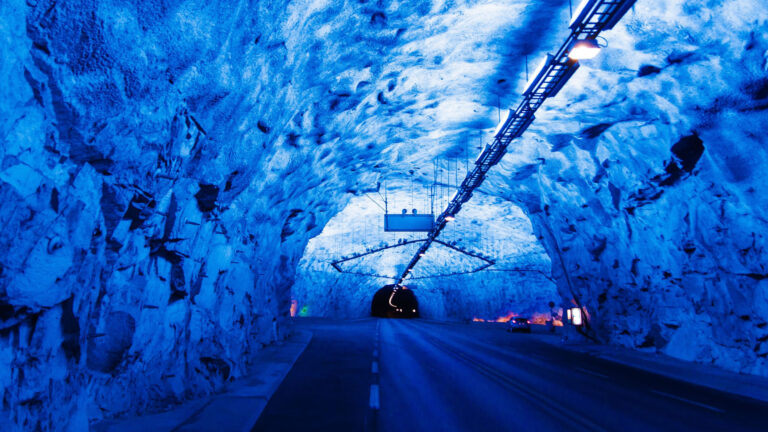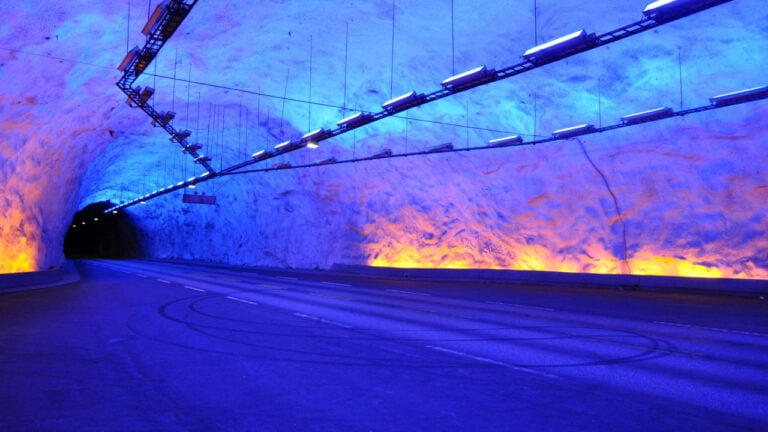The world's longest road tunnel needs an upgrade. As a result, the Laerdal Tunnel on the E16 will be closed every evening and night for several years.
Anyone travelling from Oslo to Bergen by car will likely have driven through the Lærdal tunnel. Believed to be the world’s longest, the tunnel is a highlight of any intercity road trip.

It’s also a popular route for tourists visiting the historic centre of Lærdal and the beautiful Aurlandsfjord. The tunnel features changing colour lights and large cavernous rest areas to keep drivers alert during the long journey through.
The 24.5km-long tunnel is in need of maintenance to meet European safety guidelines.
However, the consequences for the main road between Bergen and Oslo will be significant. Around 2,000 cars use the tunnel on average every day, a number that rises signficiantly in the high summer tourism season.
Night closure for the tunnel
The Norwegian Ministry of Transport has given the green light to the Norwegian Public Roads Administration's plans to upgrade the tunnel with the work starting from 2025.
The upgrade work is significant and is expected to take up to five years to complete. During the first phase of the work, the tunnel will be closed from 6pm to 6am on weekdays. A plan for weekend work is yet to be announced.

The discussion about how the upgrade should proceed has been ongoing for several years. Last year, the Norwegian Public Roads Administration suggested closing the tunnel for an entire year, which caused controversy.
“It is not possible to upgrade the tunnel without it having consequences for the outside world. We have concluded that it is better to close the tunnel in the evenings and at night than to close it entirely,” said Stig Berg-Thomassen from the Norwegian Public Roads Administration.
Convoy driving eventually
The work on the tunnel will be divided into two phases. With evening and night closures, it will take two to three years to complete the blasting work in the tunnel. Even emergency vehicles will not be able to pass through during this time.
“Conditions in the tunnel will be challenging for the tunnel workers. Therefore, we cannot allow traffic through until we have blasted and secured the mountain,” said Berg-Thomassen.
Only after the blasting work and the securing of the mountain is complete will they be able to allow traffic to pass through. Convoy driving will be permitted two to three times during the closure period.
Alternative routes
There are no good local detour options between Laerdal and Aurland. The national scenic route Aurlandsfjellet known as ‘the snow road’ is only open for a few months every year, but it isn’t suitable for heavy goods traffic.

Around 2,000 vehicles pass through the tunnel every day on average throughout the year. July is the high season when nearly 3,900 vehicles pass through the tunnel every day.
Strengthening the ferry service on the RV13 Vangsnes-Hella route is under consideration, as is establishing passenger transport by boat between Lærdal and Aurland when needed.
“Dark times for the transportation industry”
The transportation industry has been pessimistic about the upgrade of the E16 tunnel. The industry has feared both a breakdown in the transportation of goods and significant job losses.
“This will be dark times for transportation history and for transportation in Sogn,” said Arne Slinde Ahlin, CEO of Slinde Transport to NRK.
Slinde Transport's main base is located at Håbakken along the E16, close to the Laerdal Tunnel. Ahlin is clear that this will create significant challenges for them, but that evening and night closures will be a good solution for the local community.

